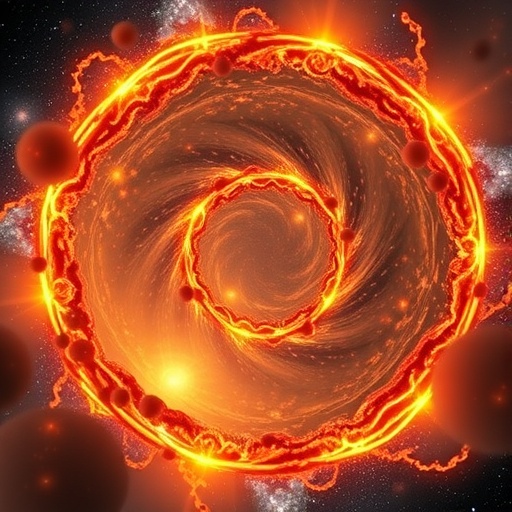A University of Queensland researcher has made a groundbreaking advancement in our understanding of the cosmos by developing a novel mathematical model that sheds light on the universe’s evolution, particularly emphasizing the interactions between collapsing regions of matter and expansive voids. This innovative approach marks a significant departure from the traditional cosmological frameworks that have dominated scientific discourse for decades. For the first time, researchers are equipped with a tool that critically incorporates the complexities of space, radically altering the perspectives that physicists and cosmologists hold regarding universe dynamics.
Dr. Leonardo Giani, the face behind this revolutionary model, worked alongside a dedicated team at the School of Mathematics and Physics at the University of Queensland. Their research harnessed data from the Dark Energy Spectroscopic Instrument (DESI), which has been instrumental in enhancing our measurement capabilities of the universe, reaching depths of 11 billion light years. The implications of this research are staggering; they extend far beyond mere academic curiosity, hinting at a re-evaluation of established cosmic theories.
The underpinnings of the conventional model posit that the universe has uniformly distributed matter particles that interact minimally. However, Dr. Giani’s findings expose a richer tapestry of interactions wherein celestial bodies such as stars, black holes, and clusters of galaxies engage dynamically through gravitational forces. These forces profoundly influence the universe’s structure, leading to voids and causal relationships that the standard model fails to adequately account for. The evolution of these cosmic structures is paramount to understanding key measurements and phenomena associated with cosmological observations.
For over three decades, scientists have grappled with the complexities of the universe as it continuously expands. Exotic theories have emerged, attempting to clarify what physicists have long baffled over. Dr. Giani’s model signifies a paradigm shift, not built on speculative premises, but rather on fundamental mathematics that enable straightforward computation of the impact of various structures in the universe on observational measurements. Using a combination of established mathematical expressions and empirical data, the model provides insight into how different sized regions—whether they be voids or clusters—contribute differently to our understanding of cosmic phenomena.
Central to Dr. Giani’s work is the identification of two critical parameters—R_c and R_v—that represent the minimum sizes of voids and clusters, respectively, which can significantly influence cosmological metrics. In practice, through plotting independent datasets including those obtained from DESI, a clear framework has emerged, showcasing not only where these regions overlap but also exposing a perplexing anomaly. Where one might expect the contours of these datasets to occupy the upper right quadrant of the plotted parameters—suggesting too large structures for existence—they occupy alternative regions, indicating that significant voids may play a pivotal role in the observed data’s anomalous behavior.
As if that were not enough, Dr. Giani’s model endeavors to address some of the most pressing issues in contemporary cosmology: the Hubble tension and the dynamics of dark energy. The Hubble tension refers to a mismatch between two different methods for determining how quickly the universe is expanding. Simultaneously, the implication of dynamical dark energy introduces a theory where energy is not a fixed quantity but rather something that may evolve over time, posing further questions of its impact on the expansion rate of the universe. This duality of challenges has left much of the scientific community eager for resolution.
Dr. Giani’s framework provides a coherent resolution to both quandaries. By assuming the possibility that dark energy might be gently diminishing, researchers can interpret expansion rate data that leads to lower measurements—creating a misleading feedback loop of solutions where one answer gives rise to another conflicting theory. However, his model allows for a more nuanced interpretation where the notion of energy weakening becomes a detailed representation of the universe’s current state rather than an absolute determinant of its evolving nature.
In this groundbreaking model, a defined region, highlighted as a green box in the plotted data, indicates where the Hubble tension is resolved. When examined through the lens of the complex structures present in the universe, the results reveal that these complexities are indeed manifesting themselves within the DESI dataset. With this new framework, Dr. Giani posits that we can reconcile previously conflicting observations and provide a clearer understanding of the cosmos.
The implications of these findings are vast, potentially changing how we approach cosmic measurements and even the fundamental principles that govern our understanding of physics. The intersection of mathematics and astrophysics in this research serves as a potent reminder of the elegance and intricacy of the universe we inhabit, offering new lenses through which future studies can be pursued. The quest to understand the cosmos is increasingly becoming a collaborative endeavor that requires integrating various disciplines and embracing the complexities rather than avoiding them.
The work encapsulated in the research performed by Dr. Giani and his team represents a significant leap forward in our cosmological comprehension. As scientists continue to unravel the mysteries of the universe, this novel approach lays the groundwork for future explorations that push beyond our current understanding. The mathematical modeling of cosmic structures as effective fluids not only provides clarity but also sparks the imagination, prompting a reevaluation of what we think we know about the universe’s origin, evolution, and ultimate fate.
Through continued investigation and refinement, this model stands to carry the field of cosmology into uncharted territories. By combining rigorous mathematical principles with observational data, Dr. Giani’s fresh perspective may redefine our journey through the cosmos, leading to an era of deeper insights and richer discoveries that expand our horizons as we seek to comprehend the very fabric of reality itself.
Subject of Research:
Article Title: Novel Approach to Cosmological Nonlinearities as an Effective Fluid
News Publication Date: 15-Aug-2025
Web References: https://doi.org/10.1103/zr92-m7py
References: Physical Review Letters
Image Credits: Dr Leonardo Giani
Keywords
cosmology, mathematical modeling, dark energy, Hubble tension, universe expansion, effective fluid, cosmic structures, DESI, gravitational interactions, astrophysics, observational data, universe evolution.




